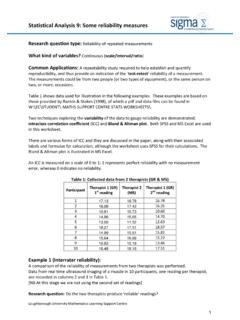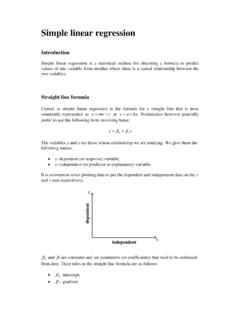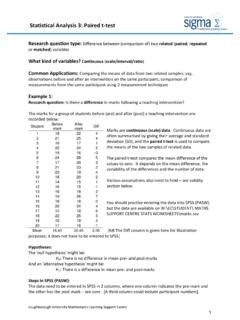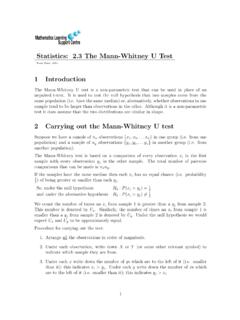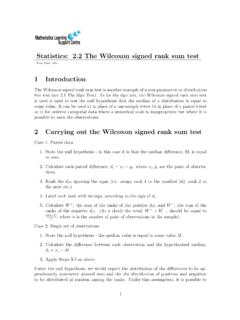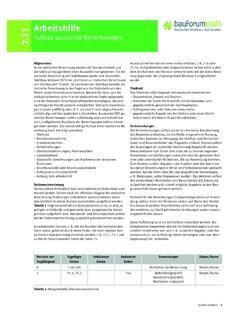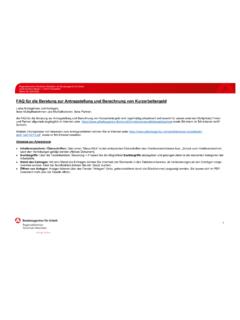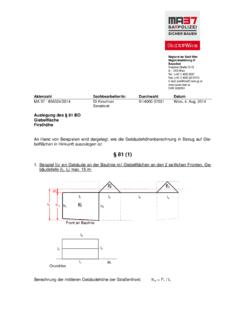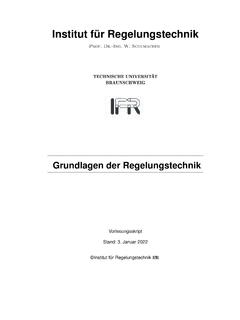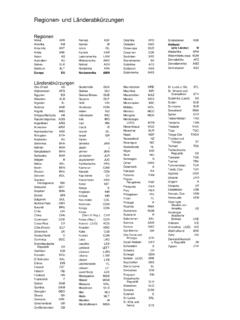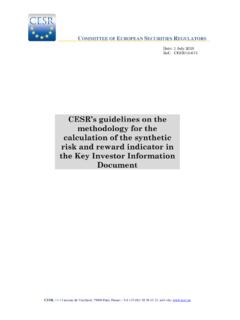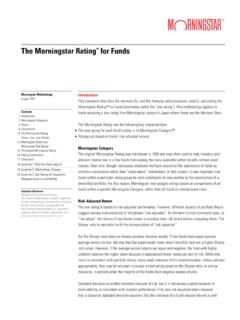Transcription of Statistics: An introduction to sample size calculations
1 Statistics: An introduction to sample size calculationsRosie Cornish. IntroductionOne crucial aspect of study design is deciding how big your sample should be. If you increaseyour sample size you increase the precision of your estimates, which means that, for any givenestimate / size of effect, the greater the sample size the more statistically significant theresult will be. In other words, if an investigation is too small then it will not detect resultsthat are in fact important. Conversely, if a very large sample is used, even tiny deviations fromthe null hypothesis will be statistically significant, even if these are not, in fact, practicallyimportant.
2 In practice, this means that before carrying out any investigation you should havean idea of what kind of change from the null hypothesis would be regarded as practicallyimportant. The smaller the difference you regard as important to detect, the greater thesample size such as time, cost, and how many subjects are actually available are constraints thatoften have to be taken account of when designing a study, but these should not dictate thesample size there is no point in carrying out a study that is too small, only to come up withresults that are inconclusive, since you will then need to carry out another study to confirm orrefute your initial are two approaches to sample size calculations .
3 Precision-basedWith what precision do you want to estimate the proportion, mean difference .. (orwhatever it is you are measuring)? Power-basedHow small a difference is it important to detect and with what degree of certainty?2 Precision-based sample size calculationsSuppose you want to be able to estimate your unknown parameter with a certain degree ofprecision. What you are essentially saying is that you want your confidence interval to be acertain width. In general a 95% confidence interval is given by the formula:Estimate 2(approx)1 SEwhere SE is the standard error of whatever you are This is because 95% confidence intervals are usually based on the normal distribution or a t-distribution for a normal distribution the value is ; for t-distributions the value is generally just over formula for any standard error always containsn, the sample size.
4 Therefore, if youspecify the width of the 95% confidence interval, you have a formula that you can solve 1 Suppose you wish to carry out a trial of a new treatment for hypertension (high blood pressure)among men aged between 50 and 60. You randomly these receivethe new treatment andnreceive a the standard treatment, then you measure each subject ssystolic blood pressure. You will analyse your data by comparing the mean blood pressurein the two groups carrying out an unpaired t-test and calculating a 95% confidenceinterval for the true difference in would like your 95% confidence interval to have width 10 mmHg ( you want to be95% sure that the true difference in means is within 5 mmHg of your estimated differencein means.)
5 How many subjects will you need to include in your study?We know that the 95% confidence interval for a difference in means is given by( x1 x2) 2(approx) sp 1n1+1n2 Hence, we want2 sp 1n1+1n2to be equal to 5 sp 1n1+1n2=sp 2n (since we are aiming for groups of the same size).In order to work out our sample sizes we therefore need to know whatspis likely to be. This iseither known from (a) previous experience ( knowledge of the distribution of systolic bloodpressure among men with hypertension in this age group), (b) using other published paperson blood pressure studies in a similar group of people or (c) carrying out a pilot study.
6 I haveused option (b) to get a likely value forspof 20 = 20 2n n2=( )2 n= 128(in each group)If you wanted your true difference in means to be within rather than 5mmHgof your estimate, this would becomen2=( )2 n= if you want to increase your precision by a factor of 2, you have to increase your samplesize by a factor of 4. In general, if you want to increase your precision by a factork, you willneed to increase your sample size by a factork2. This applies across the board whetheryou are estimating a proportion, a mean, a difference in means, etc. 2 Supposing you are investigating a particular intervention to reduce the risk of malaria mortalityamong young children under the age of five in The Gambia, in West Africa.
7 You know thatthe risk of dying from malaria in this age group is about 10% and you want the risk differenceto be estimated to within 2%. A 95% confidence interval for a difference in proportions is2given by(p1 p2) p1(1 p1)n1+p2(1 p2)n2= (p1 p2) p1(1 p1) +p2(1 p2)nif the sample size in each group is the same. As stated previously, we normall by 2. We therefore want p1(1 p1) +p2(1 p2)n = work out the required sample size, we usually takep1=p2=the value closer to ,since this would give rise to a larger standard error and therefore a larger sample size (it isalways better to err on the side of caution in sample size calculations because (a) you oftenget drop-outs, so it s better to have too many rather than too few in your sample to start withand (b) they are never 100% exact anyway, since you base them on estimates of the standarderror, not on known , in this case we have 2( ) )n= n=2( )( ) 1800(in each group)
8 To summarise, in order to carry out any precision-based sample size calculation you need todecide how wide you want your confidence interval to be and you need to know the formulafor the relevant standard error. Putting these together will give you a formula which can berearranged to Power-based sample size calculationsWe have seen above that precision-based sample size calculations relate to estimation. Power-based sample size calculations , on the other hand, relate to hypothesis testing. In this handout,the formulae for power-based sample size calculations will not be derived, just I error(false positive)Concluding that there is an effect ( that two treatments differ) when they do not = P(type I error) = level of statistical significance[=P(rejectH0|H0true)]Type II error(false negative)Concluding that there is NO effect ( that there is no difference between treatments)when there actually is.
9 = P(type II error)[=P(acceptH0|H1true)]PowerThe (statistical) power of a trial is defined to be1 [=P(rejectH0|H1true)] Power calculations : quantitative dataSuppose you want to compare the mean in one group to the mean in another ( carry outan unpaired t-test). The number,n, required in each groupis given byn=f( , ) 2s2 2 Where: is the significance level (using a two-sided test) your cut-off for regarding the resultas statistically is the power of your ( , )is a value calculated from and see table below. is the smallestdifference in means that you regard as being important to be able to the standard deviation of whatever it is we re measuring this will need to be estimatedfrom previous ( , )for the most commonly used values for and to the blood pressure example.
10 Suppose we want to be 90% sure of detecting adifference in mean blood pressure of 10 mmHg as significant at the 5% level ( power = , = , = ). We have, from above,s= 20mmHg. Using the table, we getf( , ) = This givesn=f( , ) 2s2 2= 2(20)2102= 84 You would need 84 subjects in each , if you increase the power or want to use a lower value for as your cut-off forstatistical significance, you will need to increase the sample Power calculations : categorical dataSuppose we are comparing a binary outcome in two groups of sizen. Letp1= proportion of events (deaths/responses/recoveries etc.) in one groupp2= proportion of events in the other groupWe need to choose a value forp1 p2, the smallestpractically important difference in pro-portions that we would like to detect (as significant).

